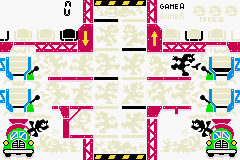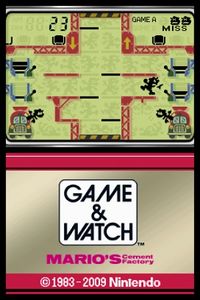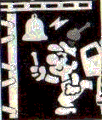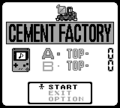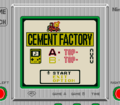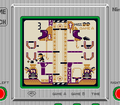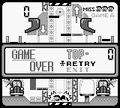Mario's Cement Factory
| It has been requested that more audio and/or video files related to this article be uploaded. Specifics: DSi version Please upload music, sound effects, voice clips, or any videos for this article. See the help page for help getting started. |
| Mario's Cement Factory | |||||||||||
|---|---|---|---|---|---|---|---|---|---|---|---|
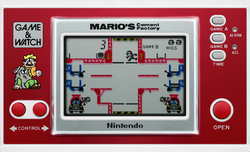 The New Wide Screen version of Mario's Cement Factory | |||||||||||
| Developer | Nintendo R&D 1 | ||||||||||
| Publisher | Nintendo | ||||||||||
| Platforms | Game & Watch, Mini Classics, Nintendo DSi, Nintendo 3DS | ||||||||||
| Release dates | Game & Watch: Mini Classics: Nintendo DSi (DSiWare): Nintendo 3DS (eShop): | ||||||||||
| Genres | Puzzle/Platformer | ||||||||||
| Ratings |
| ||||||||||
| Mode | Single player | ||||||||||
| Format | Game & Watch:
Built-in Nintendo DSi:
Nintendo 3DS: | ||||||||||
| Input | Game & Watch:
Nintendo DS: Nintendo 3DS:
| ||||||||||
| Serial codes | CM-72 (Table Top) ML-102 (New Wide Screen) | ||||||||||
- “Mario isn't risking his neck against Donkey Kong. He's up to his neck in cement!”
- —United States commercial
Mario's Cement Factory is a Game & Watch game. Two versions of the game were produced: The first was for the Game & Watch Table Top released on April 28, 1983,[1] and the second was a more conventional New Wide Screen Game & Watch that was released on June 16, 1983.[2] Mario's Cement Factory was one of the first games in the Table Top series. The Table Top game resembles an arcade cabinet, and it is more colorful than the New Wide Screen game. In both versions, Mario's mission in the Cement Factory is to open doors to prevent cement containers from overflowing. To get to the different containers, Mario has to jump onto moving platforms. The New Wide Screen version was rereleased as a Mini Classics game and is featured in the Gallery Corner in Game & Watch Gallery. It is also featured as a minigame in Game & Watch Gallery 4 with a Classic version and an updated "Modern" version.
Mario's Cement Factory also appears as one of the minigames in Game Boy Gallery, though it is simply called Cement Factory and features no characters from the Super Mario franchise, and the playable character is the same unnamed character seen in the other minigames.
Gameplay[edit]
Classic version[edit]
The game has two drivers, each in a truck under a container. Mario earns a point each time he empties a load of cement from the upper hopper and two points each time he empties a load from the lower hopper. Each container can hold only three loads of cement. Allowing the containers to overflow causes cement to spill down onto the drivers, hurting them and giving Mario one miss. Falling off an elevator platform also earns a miss, as well as touching the very top of the screen and getting crushed by an elevator platform, or touching the very bottom and getting shocked by the floor of the elevator. In all versions of the game, Mario can use an area on the lowermost portion of the elevator to save himself from touching the very bottom and getting shocked. On the Table Top and Game Boy Gallery versions, there is a similar area on the uppermost portion of the elevator. This does not appear on any other version of the game. If Mario gets 300 points without any misses, the points will be worth double until he does get a miss. If he has any misses at said score, all misses will be cleared instead. When he receives three misses, the game is over.
Modern version[edit]
The Modern version of the game has Mario working in a cookie factory. Yoshi and Toad are featured instead of the drivers, with Yoshi eating the Yoshi Cookies made on the left conveyor belt and Toad packaging the Yoshi Cookies made on the right conveyor belt. Boos also occasionally appear, taking up cookie dough slots on the second floor. Unlike in Classic Mode, however, Mario is allowed to fall down onto an elevator platform, but touching the very bottom or top still earns the player a miss. When Mario amasses 200, 500, and 700 points, a heart appears for him to remove a miss. Music is also featured in this version, with the tempo changing depending on the speed of the game.
Selecting the game without starting it also results in a humorous sequence being played. In particular, Yoshi and Toad are putting cookie batter on a conveyor belt each, only for Toad's batter to get stolen by a Boo, causing him to cry, and then the Boo drops the batter on Yoshi, with it being a large enough quantity that Yoshi is engulfed save for the eyes, while the Boo sticks out his tongue in a taunting manner as Yoshi is baffled at the entire situation.
Controls[edit]
 : Move
: Move and
and  : Open
: Open
DSiWare[edit]
Another port of the New Wide Screen version was released in August 2009 for DSiWare in Japan and March 2010 in America, Europe, and Australia. It is also available in the Nintendo 3DS eShop as DSiWare. In July–August 2012, to coincide with the release of New Super Mario Bros. 2, it was featured on the Mario folder in the main screen.
DSi Shop description[edit]
American[edit]
Nintendo first began releasing the Game & Watch series in 1980. This collection of games was available on portable LCD devices, and each title featured a game and a clock. Each Game & Watch title features two modes of play: GAME A (normal difficulty) and GAME B (more advanced play). While some controls have been changed in the DSiWare version to better suit the Nintendo DSi system, the appearance of the game itself has not been altered.
Conveyor belts carry tubs of cement to the mixers below. Use the elevators to move Mario to different levels of the factory, dumping cement from the top mixers to the mixers below and into the trucks. Earn points for every load of cement you drop from the mixers to the cement truck. Receive mistake icons by letting a mixer overflow with cement, trying to get on an elevator when you are not level with it, or hitting the floor or ceiling while riding an elevator; receive three mistake icons, and it's game over!
European[edit]
Experience a piece of Nintendo history with the Game & Watch series for Nintendo DSiWare. Each title is a perfect recreation of a classic LCD game from the early 1980s, including normal Game A and alternate Game B modes. And no Game & Watch title would be complete without the 'Watch' function - each title includes a fully functional clock. In Mario’s Cement Factory, your job is to keep the factory going. Move Mario around the platforms and elevators, pull the levers to drop cement into containers, and fill up the trucks waiting to make their deliveries. Just like other Game & Watch titles, Game B mode is the tougher challenge; with faster, randomly moving platforms.
Gallery[edit]
It has been requested that more images be uploaded for this section. Remove this notice only after the additional images have been added. Specifics: All sprites and sprite animations
Modern version[edit]
Game Boy Gallery (Cement Factory)[edit]
Mode select (Super Game Boy)
References in later games[edit]
- Mr. Game & Watch has an attack that involves him grabbing opponents with a similar pose to how Mario grabs levers in this game.
- Mr. Game & Watch appears in Working Dough, where he is posed similarly to the lever-grabbing animation from this game.
- While cutting through a work site in Brooklyn, Mario and Luigi pass by a sign that depicts a construction worker stylized after the drivers in this game.
Names in other languages[edit]
| Language | Name | Meaning | Notes |
|---|---|---|---|
| Japanese | マリオズセメントファクトリー[3] Mariozu Semento Fakutorī |
Mario's Cement Factory | |
| Chinese (Simplified) | 马力欧的水泥工场[6] Mǎlì'ōu de Shuǐní Gōngchǎng (Mandarin) |
Mario's Cement Factory | |
| German | Cement Factory[7] | - | |
| Italian | Mario nella Fabbrica di Cemento[8] | Mario in the Cement Factory |
Notes[edit]
- Early models of the Table Top version of Mario's Cement Factory used a slightly faster rearrangement of the bass riff from "Another One Bites the Dust", a song released in 1980 by the British rock band Queen, for the game start jingle.[9] This was replaced in a later revision with an original jingle.[10] An update of this jingle reappears in the Game Boy Gallery version.[11]
References[edit]
- ^ a b Mario's Cement Factory. In The Attic (British English). (Archived September 28, 2021, 07:15:07 UTC via Wayback Machine.)
- ^ a b Mario's Cement Factory. In The Attic (British English). (Archived February 19, 2020, 13:28:35 UTC via Wayback Machine.)
- ^ a b GAME&WATCH. Nintendo Co., Ltd. (Japanese). Retrieved November 24, 2025. (Archived July 21, 2021, 07:22:50 UTC via Wayback Machine.)
- ^ Official Site of Game and Watch by Nintendo. Nintendo of America (American English). Archived March 5, 2014, 22:56:43 UTC from the original via Wayback Machine. Retrieved November 24, 2025.
- ^ a b Game & Watch™ Mario's Cement Factory - Nintendo. Nintendo UK (British English).
- ^ a b GAME&WATCH. iQue (Chinese (China)). Retrieved November 25, 2025.
- ^ WorldOfSuperNintendo (October 28, 2012). Game Boy Gallery Commercial GER. YouTube. Retrieved August 11, 2025.
- ^ Game&Watch OTO and Giochi Preziosi FAQ, list of Italian Game & Watch games. gameandwatch.ch, retrieved on January 22, 2024.
- ^ Old80s: Retro Stuff And More (January 15, 2020). Game & Watch: Mario's Cement Factory (Table Top, CM-72) (Another One Bites The Dust) (1983 Nintendo). YouTube (English). Retrieved May 14, 2022. (Archived June 6, 2024, 15:52:33 UTC via Wayback Machine.)
- ^ Old80s: Retro Stuff And More (January 21, 2022). Game & Watch: Mario's Cement Factory (Table Top, CM-72A) (Alternate) (1983 Nintendo). YouTube (English). Retrieved May 14, 2022. (Archived August 10, 2024, 00:46:19 UTC via Wayback Machine.)
- ^ All Nintendo Music (November 18, 2019). GameBoy Gallery Complete Soundtrack. YouTube (English). Retrieved May 14, 2022. (Archived March 30, 2023, 22:47:20 UTC via Wayback Machine.)
External links[edit]
- Japanese DSiWare website
- North American DSiWare website
- European DSiWare website
- Info page for the Table Top version of Mario's Cement Factory on In the Attic, a website dedicated to classic videogames (Internet Archive: Wayback Machine)
- Info page for the New Wide Screen version of Mario's Cement Factory on In the Attic (Internet Archive: Wayback Machine)
| Game & Watch games | ||
|---|---|---|
| Super Mario franchise | Donkey Kong (1982, MS) • Mario Bros. (1983, MS) • Mario's Cement Factory (1983, TT/NWS) • Mario's Bombs Away (1983, PS) • Donkey Kong Hockey (1984, MVS) • Super Mario Bros. (1986, CrS | 1987, Sp | 1988, NWS) • Mario the Juggler (1991, NWS) • Game & Watch: Super Mario Bros. (2020, CoS) | |
| Donkey Kong franchise | Donkey Kong (1982, MS) • Donkey Kong Jr. (1982, NWS) • Donkey Kong II (1983, MS) • Donkey Kong Jr. (1983, TT/PS) • Donkey Kong 3 (1984, MVS) • Donkey Kong Circus (1984, PS) • Donkey Kong Hockey (1984, MVS) | |
| Miscellaneous | Green House (1982, MS) | |
| Game & Watch Gallery series | ||
|---|---|---|
| Games | Game & Watch Gallery (1997, GB) • Game & Watch Gallery 2 (1997, GB | 1998, GBC) • Game & Watch Gallery 3 (1999, GBC) • Game & Watch Gallery 4 (2002, GBA) | |
| Super Mario minigames | Donkey Kong2,4 • Donkey Kong Jr.3,4 • Donkey Kong II3 • Donkey Kong 34 • Mario Bros.3,4 • Mario's Bombs Away4 • Mario's Cement Factory4 | |
| Minigames remade with Super Mario content |
Ball2 • Boxing4 • Chef2,4 • Egg3 • Fire1,4 • Fire Attack4 • Greenhouse3 • Helmet2 • Manhole1 • Octopus1,4 • Oil Panic1 • Parachute2 • Rain Shower4 • Turtle Bridge3 • Vermin2 | |
| Gallery Corner | Message Board • Museum • Music Room | |
| Further info | Gallery (2 · 3 · 4) • Pre-release and unused content (4) • Staff (2 · 3 · 4) | |
| Related games | Action Yoshi-2 • Game & Watch Collection • Game Boy Gallery 3 Rinse-in Shampoo | |
